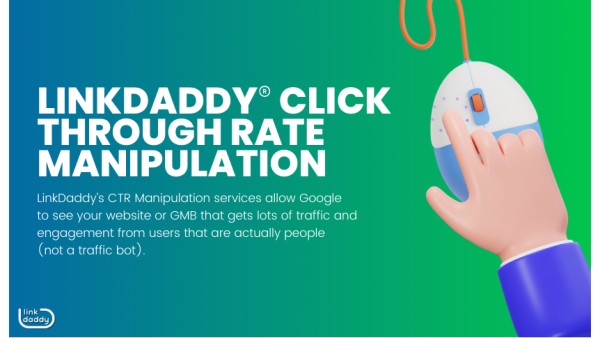CTR Manipulation Press Release for Highlighting Improved Site Metrics
Take Advantage Of CTR Adjustment to Increase Click-Through Rates
The adjustment of click-through prices (CTR) has actually emerged as a pivotal method for enhancing online engagement and driving traffic. The great line in between effective manipulation and ethical boundaries increases vital concerns about the long-lasting implications of such techniques.

Understanding Click-Through Rates
Click-through prices (CTR) offer as a vital statistics in electronic advertising and marketing, reflecting the efficiency of on the internet web content in appealing audiences. CTR is computed by splitting the variety of clicks a promotion or web link receives by the number of times it is displayed (impressions), revealed as a portion. A greater CTR shows that the material reverberates well with the target market, motivating them to take activity, while a lower CTR might suggest a separate in between the web content and its designated customers.
Recognizing CTR is necessary for optimizing advertising techniques. CTR Manipulation. Various elements influence CTR, consisting of the quality of the content, the relevance of the key phrases, the design of the promotion, and the total customer experience. Examining CTR can offer understandings right into target market choices and habits, allowing marketing experts to make data-driven choices
Additionally, CTR is essential for analyzing the performance of different advertising networks, such as e-mail campaigns, social networks advertisements, and online search engine advertising. By continually checking and analyzing CTR, marketers can fine-tune their strategies, inevitably leading to boosted interaction and improved return on financial investment (ROI) Hence, a comprehensive understanding of CTR is vital for any kind of effective digital advertising strategy.
Trick Elements to Adjust
Numerous key elements can be strategically manipulated to enhance click-through rates and take full advantage of interaction. The very first component is the headline, which should be engaging and clear, preferably sharing the worth suggestion succinctly. A well-crafted headline can catch focus and lure individuals to explore better.
Following, the usage of visuals plays an important duty. Appealing images, graphics, or videos can significantly increase interaction by breaking text dullness and supplying an aesthetic hint that draws the eye. Additionally, the positioning of components on the page should be thought about; tactical positioning can guide users to concentrate on calls-to-action (CTAs)
Another vital element is the meta description. A succinct and interesting meta summary can act as a teaser that motivates customers to click via by summing up the material efficiently. Similarly, employing urgency in language-- such as limited-time deals-- can produce a sense of immediacy, motivating customers to act quickly.
Lastly, maximizing for mobile tools is crucial, as a substantial section of users accessibility material via smartphones. Ensuring that all elements are mobile-friendly can drastically improve the chance of clicks, consequently boosting overall CTR.
Strategies for Efficient CTR Boosting
Carrying out efficient techniques for improving click-through rates calls for a strategic approach that integrates creative thinking and data-driven insights. One important approach is maximizing headings and meta descriptions, guaranteeing they are compelling and pertinent to the target audience. Crafting headings that stimulate curiosity or necessity can significantly improve customer involvement.
An additional strategy involves A/B screening numerous elements of your material, such as photos, layouts, and call-to-action buttons. This testing allows you to determine which combinations resonate finest with your target market, leading to improved performance.
Utilizing captivating visuals can additionally play a critical role in CTR enhancement. Top quality pictures, infographics, and videos can draw attention and encourage clicks. Additionally, implementing structured data can improve the appearance of your listings in search results, making them a lot more enticing.
Customization is one more efficient strategy; tailoring content Bonuses to certain individual preferences can enhance relevance and drive involvement. Last but not least, leveraging about his social evidence, such as testimonials and testimonies, can establish trust fund and motivate clicks. By using these techniques, marketers can purposefully enhance their click-through prices and drive more traffic to their web content.
Honest Considerations in CTR Adjustment
The control of click-through rates (CTR) elevates considerable ethical factors to consider that marketing professionals should browse meticulously. As companies strive for greater CTRs to improve exposure and drive conversions, the line in between acceptable optimization techniques and misleading practices can blur - CTR Manipulation. Honest marketing demands transparency and honesty, ensuring that consumers are not misdirected by overstated insurance claims or deceptive advertising and marketing methods
Furthermore, employing tactics that alter CTR metrics, such as clickbait headlines or deceptive web content, can erode consumer trust gradually. This not only harms brand name credibility yet can also bring about regulatory examination, especially in an age where customer protection legislations are coming to be increasingly rigid.

Determining Success and Adjusting Strategies
Recognizing the honest ramifications of CTR manipulation establishes the stage for effectively gauging success and readjusting techniques. The very first step in examining the efficiency of your CTR manipulation efforts is to develop clear, quantifiable metrics. These might include the general click-through rate, conversion prices, and individual engagement metrics. By consistently tracking these indications, you can obtain insights right visit this website into exactly how your techniques are performing.

In addition, be prepared to pivot your strategies based on the feedback and data gathered. If specific techniques lead to high CTR yet reduced involvement, it might indicate a misalignment in between assumptions and material top quality. Continuous refinement, driven by data evaluation, will certainly aid make sure that your CTR manipulation efforts are not only effective but also sustainable and straightened with ethical advertising methods.
Conclusion
To conclude, leveraging CTR control via tactical optimization of material elements can substantially improve target market involvement and rise click-through prices. Using strategies such as engaging headings, attractive visuals, and targeted calls-to-action, together with moral factors to consider, makes sure openness and promotes count on. Routine measurement of success and adjustment of strategies based upon data-driven understandings will assist in regular enhancement. Ultimately, a well balanced technique to CTR control will certainly generate sustainable results while maintaining customer relationships.